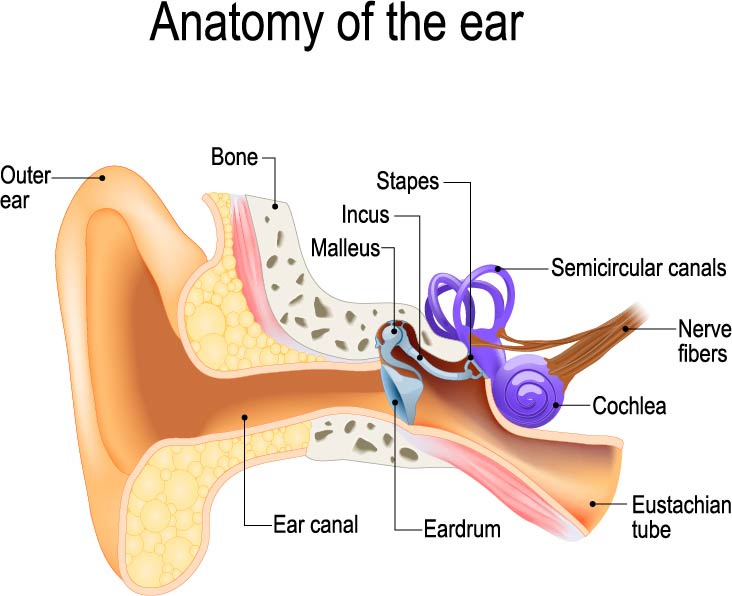Children's Emergency Department is now located in Children's Tower: 1001 E. Marshall Street.
Learn more
What’s the most common reason families visit the doctor? Ear infections! Five of six kids will have at least one before their third birthday. Many of these children have persistent or recurring ear infections, which are no fun for anyone.
 Ear infections result when bacteria spreads to fluid that builds up in the middle ear behind the eardrum. Babies’ and young kids’ eustachian tubes are smaller and more horizontal than in adults, making it difficult for this fluid to drain.
Ear infections result when bacteria spreads to fluid that builds up in the middle ear behind the eardrum. Babies’ and young kids’ eustachian tubes are smaller and more horizontal than in adults, making it difficult for this fluid to drain.
You may notice that your child tends to get ear infections along with viruses, like a cold. That’s because a runny or stuffy nose can irritate the lining of the middle ear and cause it to swell. This makes it extra hard for that fluid to drain, so it builds up which can be painful on its own. If bacteria grow in that built up fluid behind the eardrum, it can turn into an even more painful infection. Although ear infections are common with colds and other viruses, they often happen on their own too.
Ear infections can be quite painful, so your child will likely tell you their ear is hurting. If your little one isn’t talking yet, fever, irritability, tugging at the ear and difficulty sleeping may be signs they’re dealing with an infection.
A medical provider will use an instrument called an otoscope to look in the ear. If the eardrum is red or bulging, it’s a sign of an ear infection. They may also blow a puff of air into the ear using a pneumatic otoscope to see if the eardrum moves back and forth the way it should. If it doesn’t, it’s likely due to the pressure from fluid built up behind it.
If the infection is mild, we often recommend waiting a couple days to see if it clears up on its own, and treating pain symptoms with acetaminophen or ibuprofen. If it doesn’t, or if the infection is severe at the time of diagnosis, we’ll prescribe antibiotics to kill or slow the growth of the bacteria causing the infection. If kids take antibiotics too often, it’s possible their bodies could develop antibiotic-resistant bacteria, which would make future infections even more difficult to treat. That’s why we try make sure we prescribe them only when we’re sure they’re needed. If your child is prescribed antibiotics, they’ll likely start feeling better before the infection is fully cleared. Make sure they still take all of the recommended doses, so the bacteria and infection are completely wiped out.
Over-the-counter medicines such as acetaminophen or ibuprofen can help relieve pain before antibiotics are given or begin working. For children who get recurring or chronic ear infections, doctors may recommend ear tubes – or tiny tubes made of soft plastic placed in the ear drum – to allow ventilation and prevent fluid buildup, especially if the hearing is being affected too from fluid buildup.
If the pediatrician has concerns about the frequency of your child’s ear infections – usually at least three in a 6-month period or six in a year – they may refer you to an otolaryngologist (also called an ear, nose and throat, or ENT doctor). We’ll do a thorough exam of your child’s ears, nose and throat, and talk with you about their health history, as well as obtain a hearing test. We’ll consider tubes if fluid stays behind the ear between infections and/or if your child is experiencing any hearing loss. Your child’s age is another key factor. Most often, tubes are recommended for little ones between 1 and 3 years old. As they get older, the eustachian tubes are getting bigger and better able to drain fluid from the ear. Everyone is different though! Sometimes ear tubes are even appropriate for teens.
If we recommend ear tubes, and you agree that they’re the right choice for your child, we’ll schedule them for outpatient surgery. Your child will be placed under anesthesia by one of our specially trained pediatric anesthesiologists. The surgeon will make a very small hole in the eardrum and place the tiny tube in it. The procedure takes about 15 minutes. After a popsicle, some hugs and a couple hours, they’ll likely be feeling great. They won’t feel the tube, but they may notice they can hear better.
As the eardrum slowly heals, it’ll push the tube out. This usually happens over the course of about a year, but the exact timeline is unique to each child.